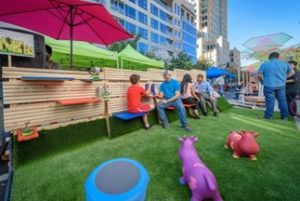Pop-up STEAM PARK(ing) Lots
Traffic jams, frustration, and parking tickets typically define the urban driving experience.
But every year on the third Friday in September – PARK(ing) Day, which falls on September 21 this year – artists, landscape architects, engineering students, kids, and activists around the world collaborate to transform curbside pavement into lounges, gardens, and other appealing spaces. The idea is to promote creativity, civic engagement, critical thinking, social interactions, and play through design.
The American Society of Landscape Architects has a number of PARK(ing) Day resources to help K-12 teachers and students showcase the design component in STEM, including a PARKing Day how-to manual with tips for choosing spots.
PARK(ing) Day offers a great way for students to collaborate with professionals and community members to solve challenges around health and safety, better streets and neighborhoods, clean water, biodiversity, or climate change. Contact your local ASLA chapter to see how you can get involved and create your own temporary parklet. Post a picture of your installation in the social media contest with #ASLAPD18 for a chance to appear in Landscape Architecture Magazine.

PARK(ing) Day got its start in 2005, when San Francisco landscape architect and Rebar founder John Bela and urban designers Blaine Merker and Matthew Passmore went searching for “unscripted fragments” of land for a public art project. They were inspired by conceptual artist Gordon Matta Clark, who created installations in New York City’s tiny, irregularly shaped lots. In San Francisco, those bits of land could be rented by tossing a few coins in a meter. “We looked at the parking spaces and thought, ‘Oh wow, this is subsidized real estate,’” Bela told CityLab in 2017.
The idea quickly spread. In the past decade, parklots have housed a BBQ, free health clinic, classroom, solar panel demonstration, lemonade stand, finger-paining studio – even a wedding.
ASLA has other educational resources, such as downloadable activity books for kids interested in learning more about landscape architecture, engineering, environmental design, and drawing. For questions or more information, contact Discover@asla.org.
Filed under: Class Activities, K-12 Outreach Programs, Special Features, Web Resources
Tags: ASLA, Class Activities, Design, installations, landscape architecture, PARKIing) Day, Public Policy, public space, Resources for Teachers, STEAM, traffic, urban infrastructure, urban planning, Web Resources








